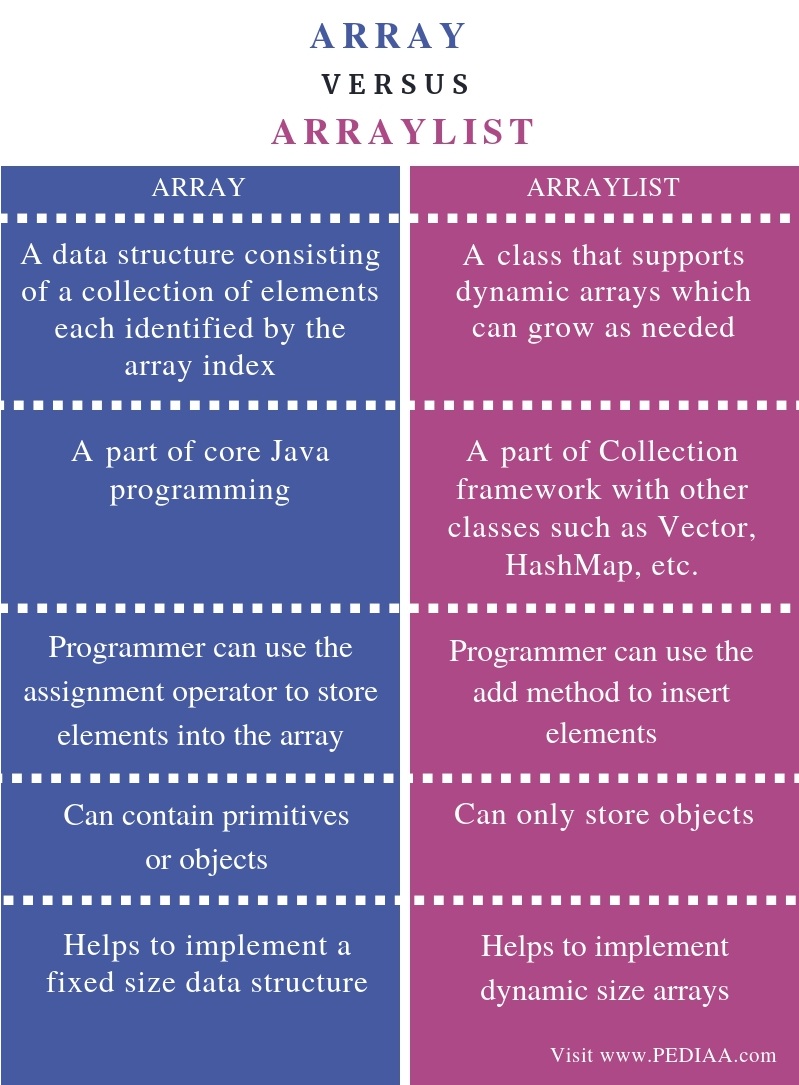
We’ll create multiple objects of the Book class and store into the ArrayList of the MainBookStore.Īnd then, get the array list of book objects from the MainBookStore and assign to the ArrayList of the NewBookStore.Īnd then, we’ll print the name of the book and id into the NewBookStore. We’ll have two more classes: MainBookStore, and NewBookStore. In this example, we’ll create a Book class which objects will be stored into an ArrayList.
#Java different array vs arraylist how to#
Sharing ArrayList of user defined objects from one class to Another in java We’ll learn how to import ArrayList of objects from one class to another class in Java Use synchronized list to avoid exception * Read class will read elements form a shared list * a shared list that is created with an Arraylist.
#Java different array vs arraylist code#
Code Example to Share ArrayList between classes import So, we will be Synchronizing the ArrayList using Collection.synchronizdList. NOTE: If two objects are performing read and write operation on same shared list, then we need to synchronize the list to avoid exception. Other differences include handling types and getting the size/length. While the size of an ArrayList can change, an Array is a set size. One the biggest differences between an Array and ArrayList is expandability.

Differences Between Arrays and ArrayLists. Perform operations add or remove on that list. While both Arrays and ArrayLists perform similar operations, they are used differently. Pass the same ArrayList to constructor of both Read and Write class constructor and initialize the list fields of both class. The Write class will add elements to an ArrayList and another Read class will read elements from the same ArrayList.Ĭreate a list using an in the main() of the Sample class. We’ll create an ArrayList in the main() method and will share it to the two different classes i.e. In other words, how to pass Arraylist from one class to another in java LinkedList linkedList = new LinkedList ( ) // ArrayList add long startTime = System.Learn how an ArrayList can be shared between different classes in a Java program. I use the following code to test their performance:ĪrrayList arrayList = new ArrayList ( ) LinkedList has O(n) time complexity for arbitrary indices of add/remove, but O(1) for operations at end/beginning of the List.ArrayList has O(n) time complexity for arbitrary indices of add/remove, but O(1) for the operation at the end of the list.* add() in the table refers to add(E e), and remove() refers to remove(int index) The time complexity comparison is as follows: Normally, most Java programmers use ArrayList instead of Vector because they can synchronize explicitly by themselves.Ħ. Because of this, it has an overhead than ArrayList. Vector is almost identical to ArrayList, and the difference is that Vector is synchronized. The real difference is their underlying implementation and their operation complexity. hasNext ( ) ) Īs shown in the examples above, they are similar to use. It is a good habit to construct the ArrayList with a higher initial capacity. Note: The default initial capacity of an ArrayList is pretty small. LinkedList, however, also implements Queue interface which adds more methods than ArrayList and Vector, such as offer(), peek(), poll(), etc. Vector each time doubles its array size, while ArrayList grow 50% of its size each time. Vector and ArrayList require more space as more elements are added.

Vector is similar with ArrayList, but it is synchronized.ĪrrayList is a better choice if your program is thread-safe. Its performance on add and remove is better than Arraylist, but worse on get and set methods. LinkedList is implemented as a double linked list. It's elements can be accessed directly by using the get and set methods, since ArrayList is essentially an array. As more elements are added to ArrayList, its size is increased dynamically. Their main difference is their implementation which causes different performance for different operations.ĪrrayList is implemented as a resizable array. From the hierarchy diagram you can get a general idea of Java Collections.įrom the hierarchy diagram, they all implement List interface. The following is the class hierarchy diagram of Collection. When we talk about List, it is a good idea to compare it with Set which is a set of unique and unordered elements.

List, as its name indicates, is an ordered sequence of elements.


 0 kommentar(er)
0 kommentar(er)
